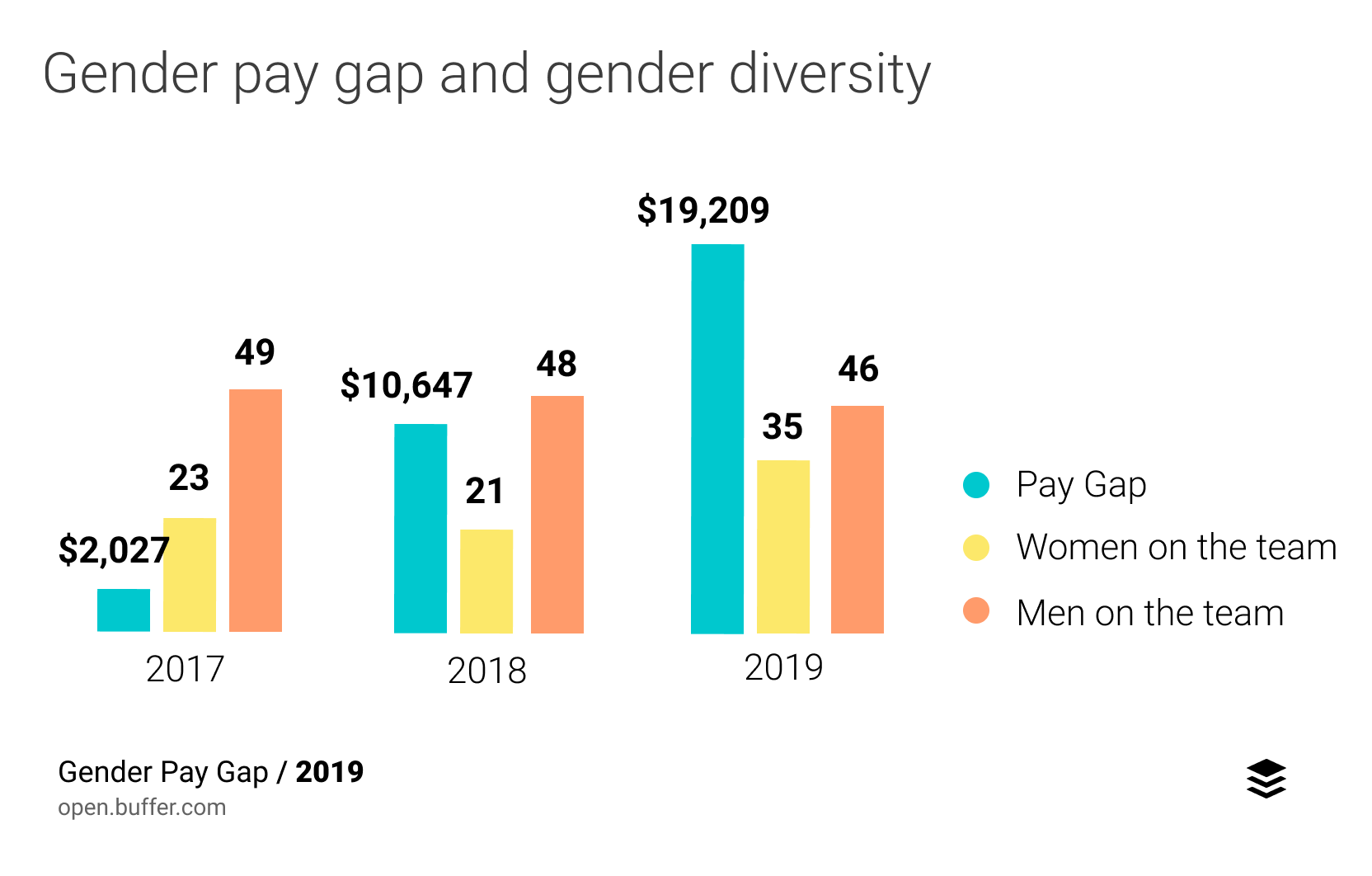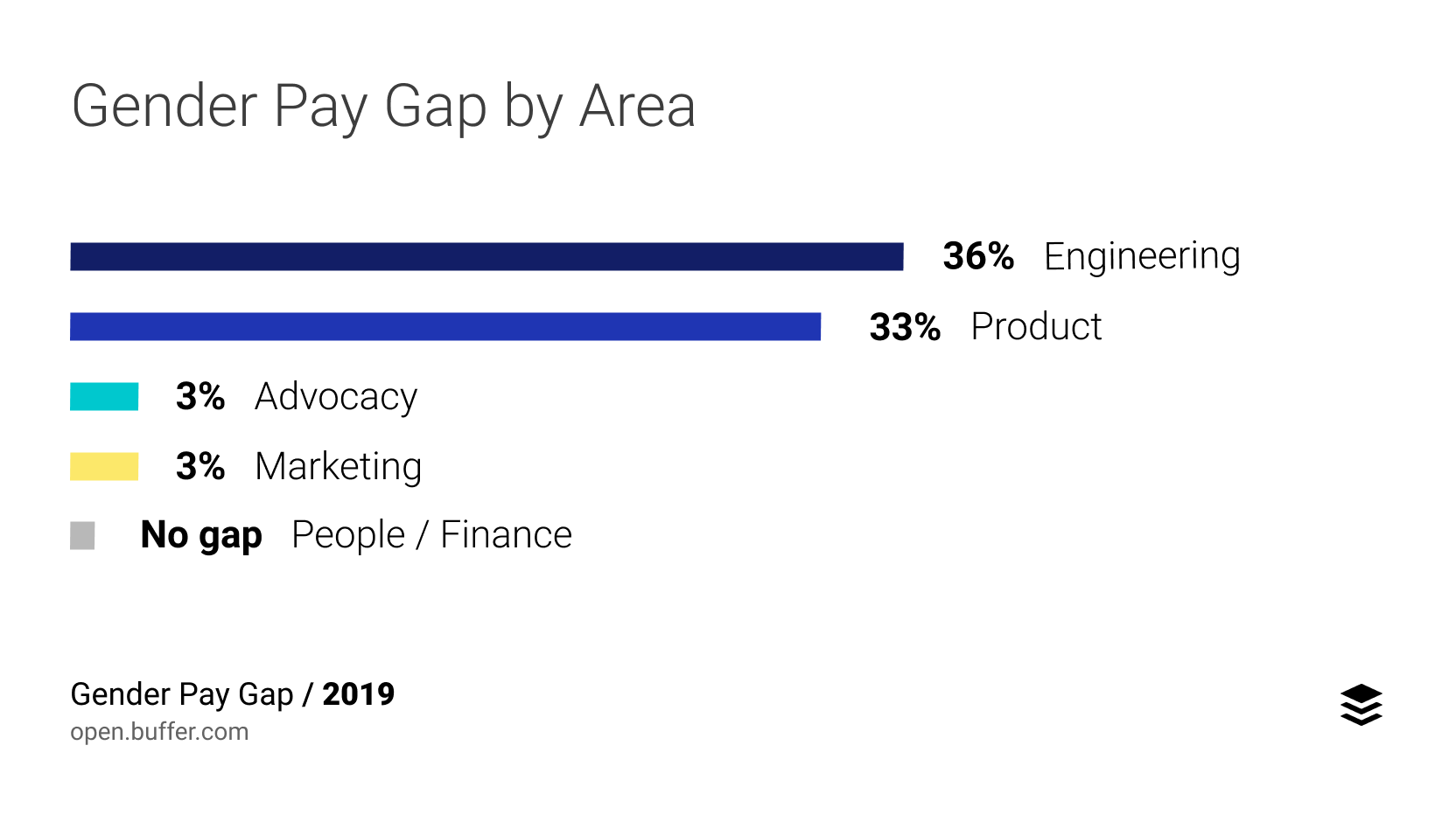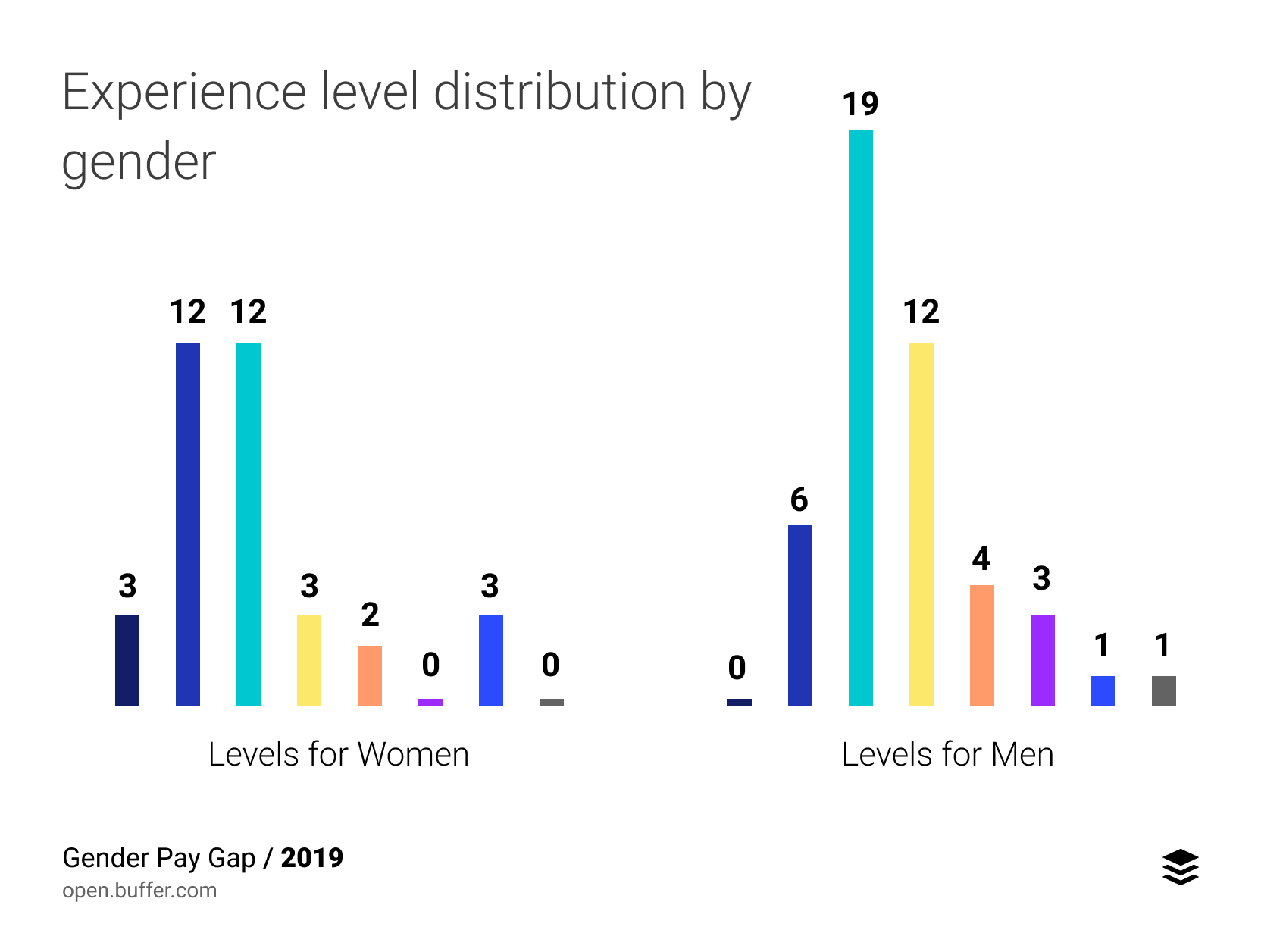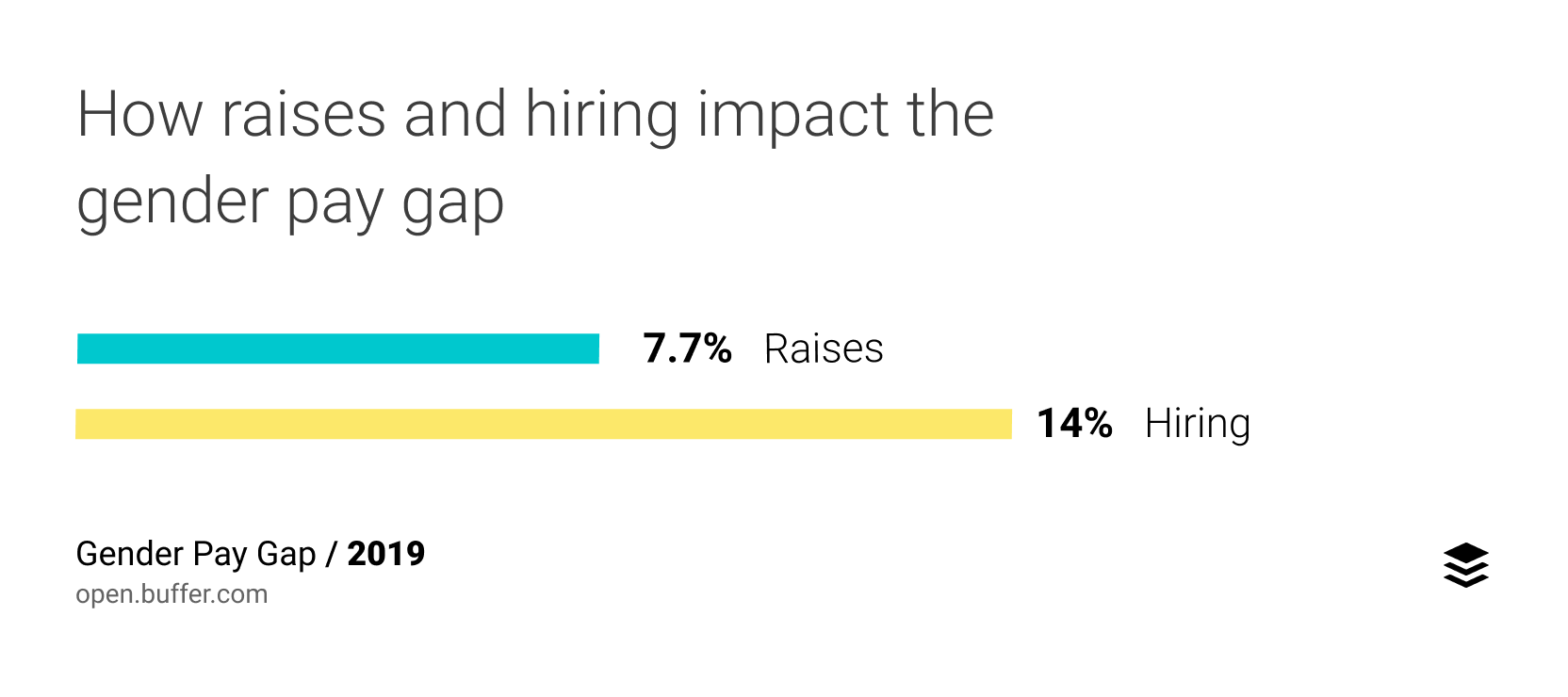
Our Latest Pay Analysis: Examining Buffer’s Gender Pay Gap in 2019
Former Director of People @ Buffer
Progress seldom looks like the straight line we all wish it might. Real life is much messier, filled with false starts, mistakes, and backtracks. That’s an especially tough truth when it comes to issues like the gender pay gap that affect real people’s lives so deeply.
But in advance of this year’s Equal Pay Day, Buffer has a progress story to tell – and it looks nothing like a straight upward line.
What is Equal Pay Day and Why Does it Matter?
Equal Pay Day is an annual recognition of the pay gap between the salaries of men and women. Overall, women in the United States are paid 80 cents for every dollar paid to men, amounting to a 20% annual gender wage gap of $10,169.
This year, the date of April 2 signifies how far into the year women must work to earn what men earned in the previous year. It’s important to note that this date in the U.S. represents the average pay for all women compared to the average pay for men.
Equal Pay Day is different for women of different races and ethnicities:
- For Asian-American women, the date is March 5, 2019 — they are paid $.85 (cents) for every dollar paid to men
- For white women, the date is April 19, 2019– $.77 (cents)
- For African-American/Black Women, the date is August 22, 2019 — $.61 (cents)
- For Native American Women, the date is September 23, 2019 — $.58 (cents)
- For Latinas, the date is November 20, 2018 — $.53 (cents)
Additionally, there’s a significant gap for moms as compared to dads:
- Moms: June 10, 2019 — $.69 (cents)
It’s also important to mention that gender identity is a much more robust category than just man or woman: There doesn’t seem to be much data on the experience of gender non-binary and genderqueer folks in tech yet.
Even within these brief bullet points we begin to get a sense of the complexity of the gender pay gap and why it’s been so persistent over the years.
But we do have a number of tools to combat this pay discrepancy, and one of the most powerful of these is transparency.
Why Transparency Matters
Women and members of underrepresented groups have long known from personal experience that informally talking about pay with peers is one of the best (and only!) ways to figure out how your pay stacks up. The whisper network is invaluable, although many U.S. companies still frown on these conversations.
In Europe, where more countries are required to report wages by gender, data suggests that openness at the company level about the gender pay gap can truly help close it. It also:
- Increases the number of women hired
- Increases the number of women being promoted
This is one reason why we continue to believe so strongly in the power of transparency at Buffer, and why we commit to this analysis every year. With that in mind, here’s the story of this year’s data.
Our Gender Pay Gap has Widened as our Team Diversity has Grown
In 2017, we had an unadjusted* average wage gap of $2,027.
In 2018, it was $10,647.
And this year, our data shows a whopping gap of $19,209.
Today, men make an average of $127,106 at Buffer, compared to women’s $107,897. Compared to last year’s 9.25% gender pay gap, this year it’s 15.1%.
Over the same time span, our team gender diversity has generally been on the rise — particularly from 2018 and to 2019, when the amount of women on the team grew 66%!
- 2017: 49 men and 23 women
- 2018: 48 men and 21 women
- 2019: 46 men and 35 women

So why has our gender wage gap grown a staggering 80.6% even as we added so many more women to the team? Even with transparent salaries? Even with a transparent, no-negotiation salary formula?
Why the Growing Gap?
The main reason is that Buffer continues to feel the effects of diversity debt, which is a theory put forward by Andrea Barrica, a former venture capitalist. From her post:
In the same way that engineers can accrue “technical debt” when they push out sloppy code, or business owners can accrue “bookkeeping debt” when they procrastinate their financials until tax time, companies can also accrue diversity debt over their life cycle. The more people your company hires until you have a diverse team (meaning an array of genders, LGBT, socio-economic backgrounds, ethnicities, ages, able-bodiedness, etc.) — the more diversity debt your organization has accrued.
Because we still have more men on the team overall, and we hired those men in our earliest days, especially in higher-paying technical roles like engineering and data, those men have had the opportunity to stay at Buffer four, five, or even six years, deepening their skills, leveling up, even moving into management roles.
Areas with the biggest percentage change in gender gap include:
- People lead roles, with a 141% increase: We added two new managers who are men and one new woman manager, while also losing another woman manager.
- Technical roles, with an 85% increase: We added many new women engineers at relatively lower experience levels to the existing men on our team.

This takes nothing away from the cohort of women we’ve hired over the past year, who are hugely impressive! But not as many have been at the same seniority levels as the men at Buffer.

We’re hiring right now and are always proactively looking for experienced women for every role. But the truth is, fewer women are entering or advancing in tech overall. Women make up less than 20 percent of U.S. tech jobs, even though they make up more than half of the U.S. workforce. Even worse, women now hold a lower share of computer science jobs than they did in the 1980s.
Another illustration of the “diversity debt” effect in reverse can be found on our People and Finance team, which had been 100% women but added a man this year. The result is a $17,528 gender gap in which women out-earn men. Once again, adding new gender diversity into a long-tenured, gender-imbalanced team leads to a lopsided effect.
We wanted to make sure we were finding the right culprit in our expanding gap, so we excluded new hires and studied the data, then excluded raises and studied the data, in order to see which was making up the bulk of the change.
- The impact of raises (excluding new teammates) amounted to an average compensation of $119,526 for women and $129,494 for men for a gap of 7.7%, compared to last year’s 9.25%.
- The impact of our new teammates (excluding raises) amounted to an average compensation of $100,720 for women and $117,254 for men for a gap of 14%.

So raises contributed to the gap, too, but by a relatively small amount compared to the team growth.
So What’s the Moral of this Story?
So what can we learn from all of this: That the secret to solving the gender wage gap is hiring only one gender?
Hardly.
What it shows us is that when you’re trying to solve a complex challenge, there are few quick fixes and way more slow, hard-fought changes. For example, if we wanted to stop customers from leaving our Buffer products, we could remove their ability to delete their account. That would certainly improve our numbers quickly! But of course the real answer is a much slower and more uncertain path: to create a better customer experience.
We’re here to do this the right way, not the easy way — and that means a long-term investment in making sure women thrive all across the tech ecosystem.
What We’re Doing to Close the Gap
This data tells us we have our work cut out for us: We need to keep adding women to our team, keep developing the careers of women on our team, and keep developing allies in the men on our team. We also need keep a very close eye on promotions to make sure that growth and opportunity is equally distributed across the team.
Additionally, this work isn’t just for gender diversity, but for many intersections of identity: folks from different generations, members of the LGBTQ+ community, people of color, veterans, folks with disabilities, and more.
But when it comes to the gender pay gap, we are continuing to work on strategically-placed interventions around all the moments where we know it is most likely to persist.
Recruiting: We’re grateful to work with partners like Tech Ladies, Power to Fly, Ada’s List and many more to meet more awesome women, femmes, and non-binary folks who might thrive on our team. We analyze each candidate pool at every stage to make sure it’s representative of the diversity Buffer needs to be great.
Job descriptions: We know women are more likely to apply apply for jobs or promotions only when they can be sure they hit 100% of the criteria (while men are fine with 60% or so), so we analyze every job description to make sure we’re only including what’s truly necessary. We also often add a disclaimer that says “Even if you’re not sure if you fill all these criteria, please apply anyway!”
Salaries: We continue to iterate on our transparent salary formula so there’s no salary negotiation when you join Buffer. This is a big spot for the gender wage gap, because the effects of a negotiation gap can be compounded over time!
Promotions: We have a transparent career framework so everyone is aware of their growth opportunities and can build their path. Every lead is briefed on bias before performance review periods.
At work: We work to offer everyone support at work through employee resource groups, unconscious bias training, ally skills training, and ongoing diversity and inclusion conversations.
Family leave: We offer (and strongly encourage!) the same amount of family leave for all genders in order to normalize leave and combat “unconscious bias” against women and mothers in the workplace. A lot of research shows that the birth of a child is when the gender wage gap really grows.
*The Difference Between Adjusted Pay And Unadjusted Pay
Since there’s no law requiring U.S. companies to disclose their gender pay gap — let alone what measure to use — numbers can vary.
Most companies calculate their pay gap by adjusting for people in similar roles who perform similar work. This type of calculation is referred to as the adjusted number (sometimes also called the controlled number).
If we tried to perform this analysis at Buffer, we wouldn’t get anywhere. Since we use a salary formula to determine pay and there is no negotiating, Buffer has no adjusted gender wage gap. This has been the case since 2013 when we first started using a formula.
“You can imagine that the company might be able to come up with an adjusted pay analysis that shows there’s not much of a gap at all,” Princeton professor of labor economics Henry Farber, who has conducted analyses on companies’ pay data, told the LA Times.
The unadjusted number is a different story. It’s calculated by looking at what all men and women make at a company, regardless of their position, experience level, or type of work.
For us, it’s a much more interesting metric, and one that gives us full accountability and nothing to hide behind.
Over to you
What takeaways do you see in these numbers?
Are there any questions we can answer for you about our data or next steps?
We’re grateful for the chance to be part of this conversation and to continue working toward equal pay for all. If you’d like to join us on this journey, we’re hiring right now and would love to hear from you.
Try Buffer for free
140,000+ small businesses like yours use Buffer to build their brand on social media every month
Get started nowRelated Articles

How the Buffer Customer Advocacy Team set up their book club, plus their key takeaways from their first read: Unreasonable Hospitality by Will Guidara.

In this article, the Buffer Content team shares exactly how and where we use AI in our work.

Here we go again. If you work in social media, it’s nothing new to adapt and change your strategy based on the ever-changing algorithms and the rise and fall of social networks. (Who else was on Vine? 🙋🏻♀️) But, of course, we wish you didn’t have to. The latest wave for social media marketers and creators is that TikTok might be banned in the U.S. The short-form video app has become one of the most widely-used social media platforms and is credited with impacting trends and cultural shifts.